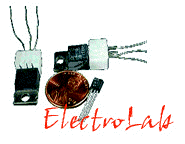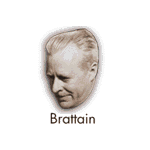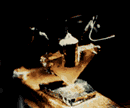






![]()
POINT CONTACT TRANSISTOR:
DEVELOPMENT
click here to learn about the scientific aspects of this
transistor
T he point contact transistor was the first amplifying semiconductor device. Yes, by amplifying, we mean making a weak current stronger. Now we've been saying that the transistor is one of, if not the greatest invention of our time. And you may be thinking, "All it does is it makes weak currents larger?" In fact, apart from acting as a switch, that is all it does. It sounds like very little, but after reading this section, go to the Applications, where it is explained why these two functions are the two most important functions within the circuits of our everyday appliances.
 Walter Brattain, a scientist and
co-inventor of the transistor, let his actions speak louder than his words and built the
first point contact transistor. Another colleague of his, and also co-inventor of the
transistor, John Bardeen, informed Dr. Brattain that he would need to metal
contacts to be within 0.002 inches of each other. Now if that sounds like a very
small space to you, you're right, it is! The problem was that at the time, the smallest
wire was three times the width they would require!
Walter Brattain, a scientist and
co-inventor of the transistor, let his actions speak louder than his words and built the
first point contact transistor. Another colleague of his, and also co-inventor of the
transistor, John Bardeen, informed Dr. Brattain that he would need to metal
contacts to be within 0.002 inches of each other. Now if that sounds like a very
small space to you, you're right, it is! The problem was that at the time, the smallest
wire was three times the width they would require!
 To conquer this problem, Brattain took a piece of gold foil, and wrapped it
over the point of a plastic triangle. He proceeded to take a razor blade a slice the foil
that lay on the point of the triangle. By doing this, he created a gap between two metal
(in this case, the metal was gold foil) contacts, which lay only a hair-width apart.
Getting spurred on by this moral victory, Brattain tried to see if his transistor would
work. And when he tested it, it did! The first ever transistor had been invented!
To conquer this problem, Brattain took a piece of gold foil, and wrapped it
over the point of a plastic triangle. He proceeded to take a razor blade a slice the foil
that lay on the point of the triangle. By doing this, he created a gap between two metal
(in this case, the metal was gold foil) contacts, which lay only a hair-width apart.
Getting spurred on by this moral victory, Brattain tried to see if his transistor would
work. And when he tested it, it did! The first ever transistor had been invented!
This transistor was, however, about half an inch high once it was completed. Today, about 7 million transistors can fit onto a single computer chip that is about 1cm x 1cm in size! But at the time, there were no doubts that the Point Contact Transistor was one amazing piece of technology.